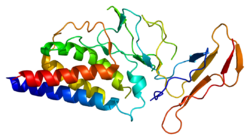CD25
| Interleukin-2 receptor subunit alpha | ||
|---|---|---|

|
||
| according to PDB 1Z92 | ||
| other names |
TAC antigen, p55, IL2RA, |
|
| Properties of human protein | ||
| Mass / length primary structure | 272 amino acids , 30,819 Da | |
| Identifier | ||
| External IDs | ||
CD25 (synonym IL2Rα ) is a membrane protein that is one of the type I cytokine receptors .
properties
CD25 is the polypeptide alpha chain of the interleukin-2 receptor, the on activated T-lymphocytes and on constitutive regulatory T cells (Treg) expressed is. Intracellularly, it has GTP exchange factor activity. CD25 binds to CD122 and forms a heterodimeric receptor for interleukin-2. CD25 is used together with Foxp3 and CD4 as a surface marker for regulatory T cells. With anti-CD25 antibodies, a cell depletion of, among other things, regulatory T cells can be carried out. The anti-CD25 antibody daclizumab is used to treat multiple sclerosis .
A CD25 deficiency or interleukin-2 receptor alpha chain deficiency is an immunodeficiency that is associated with mutations in the interleukin-2 receptor alpha (CD25) (IL2RA) gene. Mutations can lead to the expression of a defective α chain or the complete lack of the essential, high-affinity interleukin-2 receptor. The consequence is a syndrome called IPEX- like or SCID .
CD4 + CD25 high are responsible for the active control of autoimmune processes. The proportion of circulating CD4 + CD25 high T cells in healthy people is 0.6% to 7.9% of all CD4 + T cells. Reduced levels of CD4 + CD25 high T cells have been found in patients with autoimmune diseases , particularly in those with juvenile idiopathic arthritis , psoriatic arthritis , hepatitis C associated mixed cryoglobulinemia , autoimmune liver diseases , lupus erythematosus and Kawasaki syndrome . Low levels of circulating CD4 + CD25 high T cells also correlate with higher disease activity and a poorer prognosis. It is assumed that the reduced level is caused by the impaired proliferation of the peripheral CD4 + CD25 high T cells. This disrupts the balance between proinflammatory and regulatory T cells, which leads to a reduction in self-tolerance.
literature
- AK Abbas, AH Lichtman: Cellular and Molecular Immunology. 5th edition. Saunders, Philadelphia, 2003, ISBN 0-7216-0008-5 .
- M. Walport, K. Murphy, P. Travers: Janeway Immunology. 7th edition. Spektrum, Akad. Verlag, Heidelberg 2009, ISBN 978-3-8274-2047-3 .
Individual evidence
- ↑ S. Sakaguchi, N. Sakaguchi, M. Asano, M. Itoh, M. Toda: Immunologic self-tolerance maintained by activated T cells expressing IL-2 receptor alpha-chains (CD25). Breakdown of a single mechanism of self-tolerance causes various autoimmune diseases. In: J Immunol. 155 (3), Aug 1, 1995, pp. 1151-1164.
- ^ JH Buckner: Mechanisms of impaired regulation by CD4 (+) CD25 (+) FOXP3 (+) regulatory T cells in human autoimmune diseases. In: Nature Reviews Immunology . Volume 10, Number 12, December 2010, pp. 849-859, doi: 10.1038 / nri2889 . PMID 21107346 , PMC 3046807 (free full text).
- ↑ N. Pfender, R. Martin: Daclizumab (anti-CD25) in multiple sclerosis. In: Experimental neurology. Volume 262, Pt A, December 2014, pp. 44-51, doi: 10.1016 / j.expneurol.2014.04.015 . PMID 24768797 .
- ↑ Christian Dejaco, Christina Duftner, Beatrix Grubeck-Loebenstein, Michael Schirmer: Imbalance of regulatory T cells in human autoimmune diseases. In: Immunology . 3. Edition. No. 117 , 2006, PMC 1782226 (free full text).